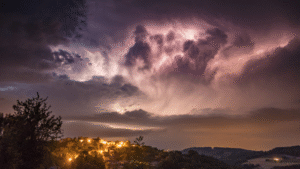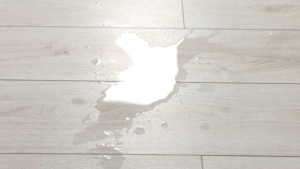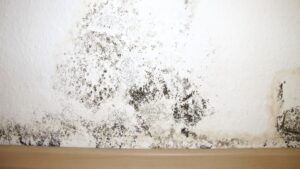Storm damage refers to the damage caused to buildings, vehicles, natural landscapes, and infrastructure by hurricanes, tornadoes, thunderstorms, high winds, hail, lightning, heavy rain and other severe weather events. The extent and nature of storm damage can vary significantly depending on the storm’s severity.
A thunderstorm accompanied by rain can cause severe property damage. Water infiltration is a common consequence of thunderstorms. Water can damage your electrical outlets, items, walls and ceilings. Standing water can harbor harmful microorganisms, creating unsanitary conditions. Strong winds during a storm can blow your roof off or lift and rip roof shingles. Damaged and missing shingles are one of the most common causes of roof leaks.
Signs of Storm Damage
After a storm, have a professional inspect your home even if everything seems alright. Remember some signs of storm damage aren’t immediately noticeable. You may miss such signs, a professional won’t. Hazards lurk in every corner of a storm damaged home, which is why you shouldn’t enter it till your chosen storm damage restoration professional finishes the storm damage repair in San Rafael and gives the go-ahead.
Here are some common signs of storm damage.
Roof Damage
High winds can throw debris on your roof, damaging it. A storm can blow off your roof shingles or cause serious damage to your roof tiles or flashing. One of the most common signs your asphalt shingles are damaged is shingle granules accumulating in your gutters.
Exterior Damage
A strong wound can cause cracks, dents, or holes in your siding. Vinyl siding can crack in cold weather, while aluminum siding may develop dents. Windows are extremely vulnerable to wind damage. High winds can cause window frames to weaken or break or lead to window screen damage. During a high wind event accompanied with heavy rain, water can find its way into your foundation, damaging it. A damaged foundation can result in cracks and bent walls. In some cases, unaddressed foundation damage can cause structural collapse.
Water Damage
Water damage can impact both your property’s interior and exterior. After a storm, check your roof and attic for signs of water damage such as damp insulation, cracks in the attic ceiling, damaged shingles, flashing damage, and bubbling or flaking paint. Make sure water isn’t ponding on your roof and check your roof shingles to ensure they haven’t absorbed moisture.
When inspecting the interior, watch out for signs of water damage including water stains on your walls, floor, and ceiling. Water infiltration can lead to mold growth. You know you have a mold problem if you notice a damp, musty odor emanating from your floors or walls. Do not try to remove mold yourself as you may make a mistake that can lead to cross contamination or accidentally breathe in mold spores. If you notice signs of mold in your home, hire a professional.
Damaged Wires and Electrical Appliances and Outlets
Lighting accompanied with a storm can cause power surges, damaging your electrical systems and appliances. Electrical wires exposed to water can corrode. If you notice wires lying in an area submerged in water, make sure it is off-limits and reach out to a storm damage restoration professional for help as soon as possible.
What to do After a Storm?
After a storm, first and foremost ensure that you and your family are safe. If you or a loved one is injured, dress the wound. Seek medical attention for any serious injuries. Stay updated with local weather forecasts and watch out for important announcements, emergency instructions, or advisories by government agencies.
Once it’s safe, inspect your home for damage. Look at your roof from the ground or climb a ladder and visually inspect your roof. Do not try to walk on your roof after a storm as strong winds may have caused extensive roof damage, affecting the roof’s structural integrity. Take photos of the affected areas for insurance purposes. When inspecting your home, watch out for potential hazards including broken glass, exposed nails, and weakened structures.
Stay away from downed power lines and report them to the utility company immediately. Assume all wires on the ground are live wires and dangerous. Check your gas, water, and electrical lines for damage. If you suspect any damage, or if you smell gas, shut off utilities at the source and contact professionals for inspection.
Stay away from wet wires and flood water as it may be contaminated. Contact your insurance company as soon as possible to file a claim.
Reach out to a Professional for Help
Once you have a rough idea of the extent of storm damage, hire a professional to carry out storm damage repair in San Rafael. Storm damage restoration professionals have the expertise and experience to assess and repair damage caused by storms quickly and effectively. They have undergone extensive training and are able to detect problems that might not be apparent immediately after a storm.
Storm damage can lead to hazardous conditions. If you decide to restore your storm damaged building yourself, you may come in contact with harmful materials. Professionals are trained to navigate safety hazards and handle hazardous materials. When it comes to mitigating storm damage, time is of the essence. A professional gets stuff done right the first time. They have an eye for detail and avoid restoration mistakes that can lead to delays or cost overrun.
From water extraction machines to dehumidifiers restoration professionals have access to the necessary equipment and materials to carry out storm damage repair in San Rafael.
West Coast Fire & Water is a leading storm damage restoration service in San Rafael. Whether your home or office was damaged in a storm, we can help. Our track record of completing complex, multifaceted storm damage restoration projects on time sets us apart from other San Rafael storm damage restoration companies. To schedule an appointment, call 415-499-9000.

Marketing Director, West Coast Fire & Water
Christian Ahlmann is the Marketing Director at West Coast Fire & Water, a California restoration company providing water, fire, mold, biohazard, storm, and reconstruction services across multiple locations. He leads brand, content, and demand programs that support rapid response and customer education. His background blends operational storytelling, community engagement, and crisis communications.



